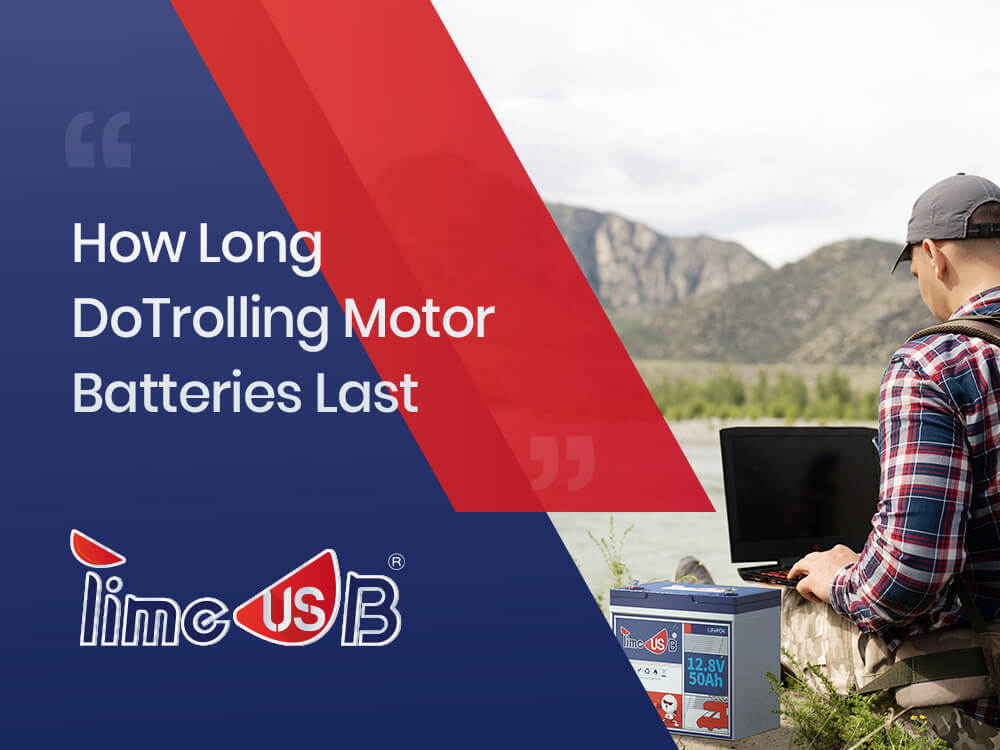[Newest] How to Charge LiFePO4 Battery - Timeusb
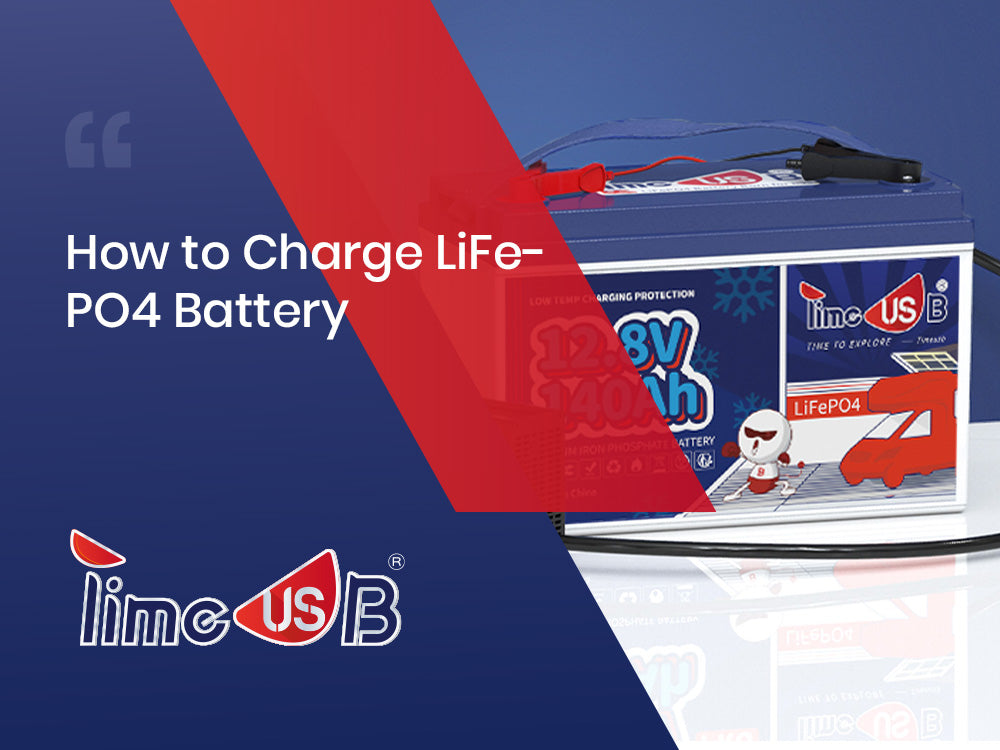
One of the most frequent inquiries from our customers is how to charge a LiFePO4 battery. The answer is straightforward: use a LiFePO4 battery charger specifically designed for this type of battery. Avoid using chargers meant for other lithium ion chemistries, which typically have higher voltages than what LiFePO4 requires.
We are sometimes asked if lead-acid battery chargers can be used for charging lithium iron phosphate, and the answer is not recommended.
In this article, we’ll discover why charging LiFePO4 battery with lead-acid charger is not recommended and know 3 best ways to charge LiFePO4 battery, let’s dive in.
Can I Charge LiFePO4 Battery with A Lead-Acid Battery Charger
To answer this questions, let's know the charging logic of LiFePO4 battery.
LiFePO4 Battery Charging Logic
At first, let's know the LiFePO4 battery charging logic.
The matierial characteristics of the LiFePO4 battery determine that its charging curve is obviously different from that of a lead-acid battery. Compared with a lead-acid battery, the LiFePO4 battery has a simpler charging process and mode. Therefore, it is recommended to select LiFePO4 for your charging mode. Here's a guide of the 6 mistakes to avoid when charging lithium battery, read it before you start charging.

LiFePO4 Charging Mode
Take Timeusb 12V 100Ah Pro LiFePO4 battery for example.
CC (Constant Current) Phase (T1)
In the beginning, a discharged battery will be charged with a constant current and voltage will be climbing steadily until reaching the constant voltage setpoint which varies for different charging methods.
CV (Constant Voltage) Phase (T2)
The battery maintains a constant voltage during this phase while the current gradually decrease to 2A (0.02C) which is also known as tail current. At this point, the charging is cut off and the battery is fully charged.
Tail current (A)= Battery Capacity*0.02C. Eg:100Ah*0.02C=2A tail current.
Charging a LiFePO4 battery with a lead-acid charger is not recommended for several reasons:
- Voltage: Lead-acid and LiFePO4 batteries have different voltage requirements. LiFePO4 batteries typically have a nominal voltage of 3.2-3.3 volts per cell, while lead-acid batteries have a nominal voltage of 2.0 volts per cell. Using a lead-acid charger could overcharge the LiFePO4 battery and potentially cause damage.

- Charging Algorithm: Lead-acid chargers use a different charging algorithm compared to LiFePO4 batteries. LiFePO4 batteries require a specific charging algorithm to prevent overcharging and maximize the battery's performance and lifespan. Using a lead-acid charger with the incorrect charging algorithm can result in improper charging and decreased battery life.
- Safety: LiFePO4 batteries have different safety requirements compared to lead-acid batteries. Using a lead-acid charger could potentially overheat or damage the LiFePO4 battery, leading to safety hazards, including the risk of fire or explosion.
To ensure the optimal performance, safety, and longevity of LiFePO4 batteries, it is recommended to use a charger specifically designed for LiFePO4 batteries that follows the correct charging algorithm and voltage requirements.
Timeusb 14.6V 40A LiFePO4 battery charger and Timeusb 24V 20A lithium battery charger have smart 3-Stage Charging Mode (pre-charge, CC, and CV), which is dedicated to LiFePO4 battery. It can accurately identify battery voltage, automatically switch charging modes, and provide fast and efficient charging for lithium batteries.
3 Best Ways to Charge LiFePO4 Battery
1. Charge LiFePO4 Battery with Lithium Iron Phosphate Battery Charger
Charging LiFePO4 batteries using a Lithium Iron Phosphate (LiFePO4) Battery Charger is the most optimal method for several reasons.

Firstly, these chargers provide precise voltage and current control during charging to prevent overcharging, which can damage the battery and reduce its lifespan.
Secondly, LiFePO4 battery chargers terminate the charging cycle at the recommended charge termination voltage level of around 3.6-3.65 volts per cell, extending the battery's lifespan. Thirdly, cell-balancing technology ensures uniform charging across all cells, reducing imbalances that negatively impact performance and longevity. Fourthly, temperature sensors monitor the battery's temperature during the charging process, allowing adjustments to ensure safe charging and prevent overheating.
Finally, LiFePO4 battery chargers are compatible with Battery Management Systems (BMS), ensuring the battery remains protected during charging.
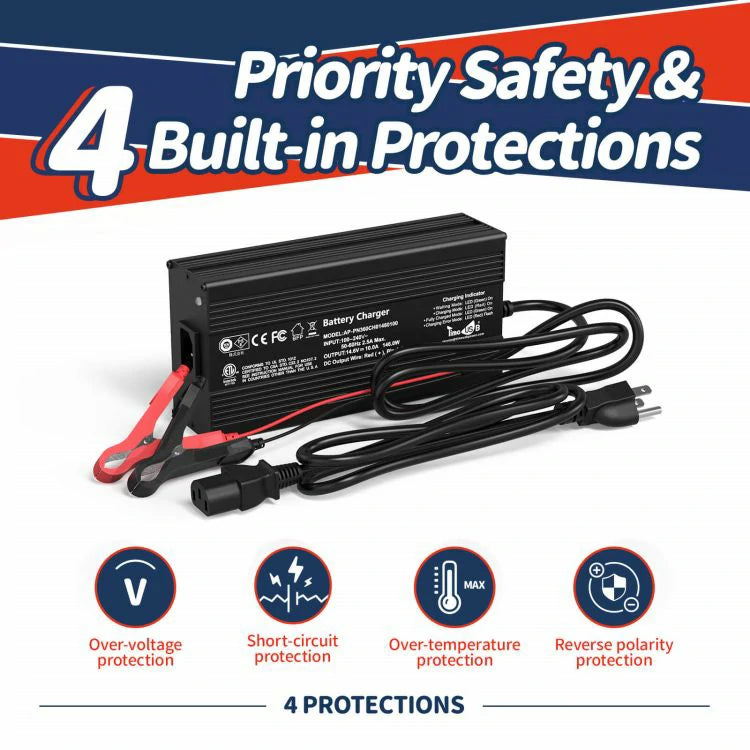
In summary, using a LiFePO4 Battery Charger provides efficient and safe charging for LiFePO4 batteries, with precise voltage and current control, automatic charge termination, balancing technology, temperature monitoring, and compatibility with BMS systems, all of which help maintain the battery's performance and extend its overall lifespan. Therefore, such chargers come highly recommended for charging LiFePO4 batteries.
2.Using An Alternator (And A DC-DC Charger)
An excellent charging solution for RVs and boats with a battery storage setup is using an alternator to charge LiFePO4 batteries.
An alternator is a generator that converts mechanical energy into electrical energy, producing alternating current (AC). The attached rectifier then converts the AC into direct current (DC).
It is an essential component of every combustion engine vehicle's electrical system, responsible for charging the starter battery used to start the engine. With some modifications, this electrical system can also be utilized to charge a battery bank, including LiFePO4 batteries, while driving the vehicle.

LiFePO4 batteries have low internal resistance when not fully charged, which means they can draw any amount of current from the alternator, potentially overheating it and damaging the battery.
To prevent these issues, a DC/DC charger limits the current drawn from the alternator, avoiding overheating. It also regulates the output voltage to match the required charging voltage of the LiFePO4 battery, preventing overcharging and ensuring safe and efficient charging.
3. Charging LiFePO4 Battery with Solar Panel
It is not only possible but highly recommended to use a solar energy system for charging LiFePO4 batteries. This is because solar panels generate the energy used for charging, rather than drawing from another energy source such as shore power.
Things you need when charge with solar panel.
- Solar panels: Solar panels convert energy from sunlight into electrical energy, which is regulated by a charge controller according to the battery's charging requirements.
- Charge controller: A charge controller is essential to regulate the charging process and prevent overcharging or undercharging of the LiFePO4 battery. Make sure to use a charge controller specifically designed for LiFePO4 batteries to ensure compatibility.
- Batteries: The battery stores the energy generated by the solar panels as chemical energy.

How To Charge Your LiFePO4 Batteries in Parallel & in Series
To ensure safe and efficient charging, charging LiFePO4 batteries in either parallel or series requires specific considerations. Here is a summary of how to charge your LiFePO4 batteries in both parallel and series:
Charging LiFePO4 Batteries in Parallel
Connect all battery positive terminals together, followed by the negative terminals to form a single battery pack.
Charging LiFePO4 batteries in parallel or series requires careful consideration to ensure safe and efficient charging. It is essential to use a charge controller specifically designed for lithium batteries to connect the battery pack to the charger, regulating the charging process and preventing overcharging while balancing the voltage across each battery.
It's recommended to monitor the charging process regularly to ensure that the charge controller maintains a stable charging rate for all batteries in the pack. Once the batteries are fully charged, disconnect them from the charger to prevent damage.
For optimal performance and longevity of your lithium batteries when connecting them in parallel, it is advised to charge each battery individually before making the parallel connection(s). After charging, use a voltmeter to check the voltage of each battery a few hours later, ensuring they are within 50mV (0.05V) of each other before paralleling. This procedure minimizes the likelihood of any imbalance between the batteries, enhancing system performance.
Over time, it is possible to experience a decrease in the battery bank's capacity. If this occurs, disconnect the parallel connections and charge each battery individually before reconnecting. This action helps balance the battery voltages and restore the battery bank's capacity.
Charging LiFePO4 Batteries in Series
When connecting lithium batteries in series, it is advisable to follow similar procedures as when connecting them in parallel. Charging each battery individually and checking the voltage to ensure they are within 50mV (0.05V) of each other before making the series connections helps minimize imbalances between the batteries, promoting optimal performance. This approach ensures that the batteries charge as evenly as possible, maximizing their capacity and extending their overall lifespan.
Here are the steps to follow when charging LiFePO4 batteries in series:
- Connect the positive terminal of one battery to the negative terminal of another battery until you have connected all of the batteries in series, creating a higher voltage battery pack.
- Use a charge controller specifically designed for lithium batteries with a rating suitable for the total voltage of the battery pack to connect the battery pack to the charger.
- Monitor the charging process regularly to ensure that the charge controller is maintaining a stable charging rate for the entire battery pack.
- Disconnect the battery pack from the charger once it is fully charged.
Note: It's crucial to balance the voltages across each battery during the charging process to prevent imbalances that could lead to reduced performance and shorter lifespan. Ensure that the charge controller comes with cell-balancing capabilities or use a separate cell-balancer to ensure that each battery receives an equal amount of charge. By following these steps, you can safely and efficiently charge your LiFePO4 batteries in series while promoting optimal performance and longevity.
Other Commen Questions about Charging LiFePO4 Battery
1. How to charge LiFePO4 battery in the cold?
If you live in the areas where the winter is long. Batteries like Timeusb 12V 140Ah which has low temperature protection is quite important to ensure the protection of battery.
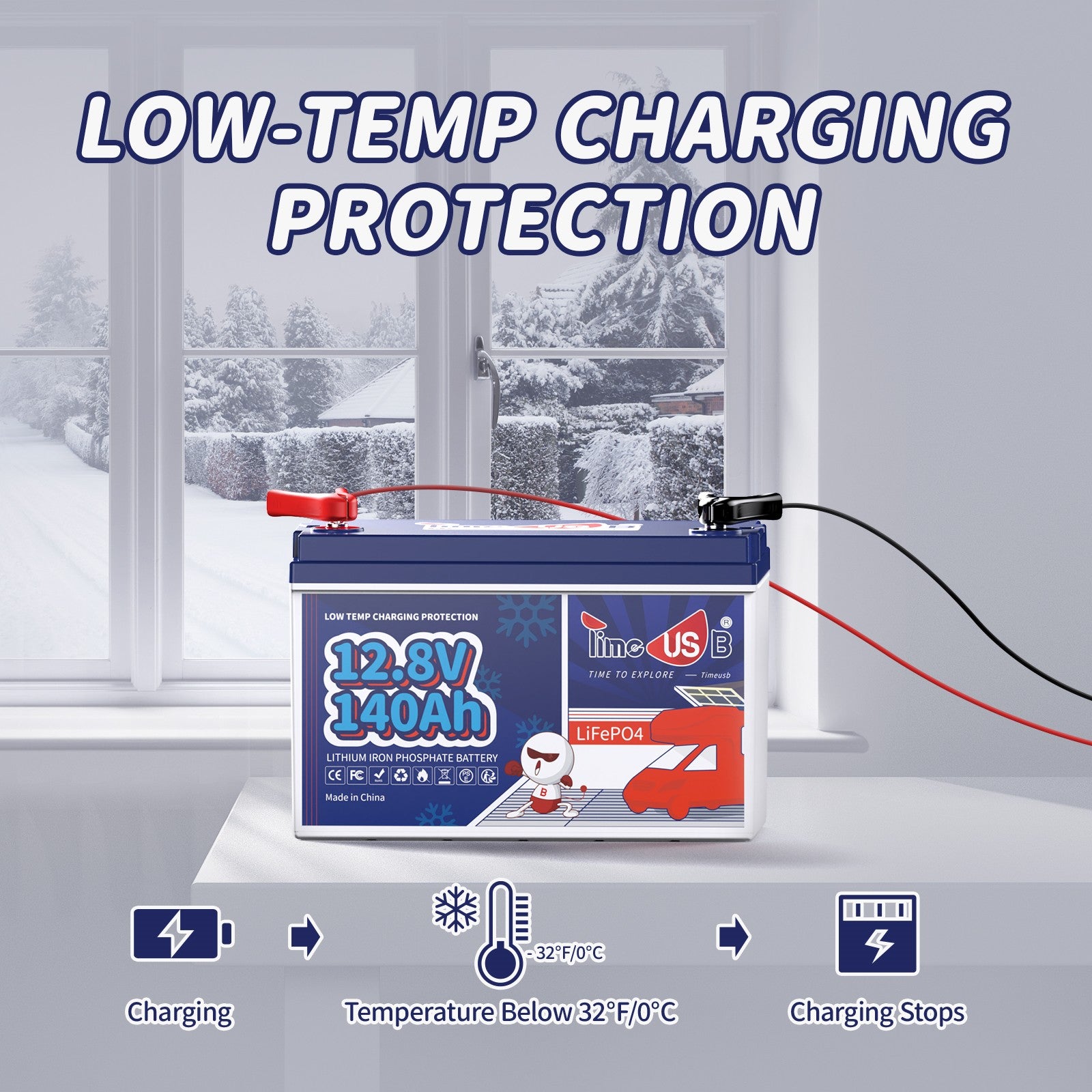
Here are some tips to charge LiFePO4 battery in the cold.
- Keep the Battery Warm: LiFePO4 batteries operate best at temperatures above 15°C (59°F), so it's crucial to keep them warm during the charging process. One way is by using an insulated bag or container to maintain the battery's temperature while charging.
- Use a Charger with Temperature Compensation: A charger with temperature compensation adjusts the charging voltage and current according to the battery's temperature, ensuring safe and efficient charging. Make sure to use a charger specifically designed for LiFePO4 batteries that includes this feature.
- Charge at a Lower Rate: Charging LiFePO4 batteries at a lower rate can help prevent overheating and extend their lifespan. Check if your charger has a lower charge rate option or use a charger with adjustable current settings.
- Monitor the Charging Process: It's critical to closely monitor the charging process in cold temperatures to ensure proper charging without overheating. Periodically check the temperature and voltage levels and reduce the charging rate if the battery gets too hot.
- Preheat the Battery: If possible, preheat the battery before charging by placing it in a warm location for some time. This helps improve its temperature and ability to accept a charge.
By following these tips, you can safely and efficiently charge your LiFePO4 battery in cold temperatures, optimizing its performance and extending its overall lifespan.
2. Should I fully charge my LiFePO4 battery?
When using your LiFePO4 battery, it is recommended to charge it fully before each use. This ensures that you have the maximum capacity available for your application and allows the battery to deliver optimal performance.
However, when it comes to long-term storage, it is generally advised to store LiFePO4 batteries at a state of charge (SoC) at 50%. Storing the battery at this SoC helps to prevent self-discharge and minimizes the degradation that can occur over time. It is also important to periodically check the battery's charge level during storage and recharge it if the SoC drops too low to maintain its health and longevity. Learn more on how to properly store your LiFePO4 battery.
It's worth noting that specific recommendations may vary depending on the manufacturer and battery model, so it's always a good idea to consult the battery's user manual or check with the manufacturer for their specific guidelines on charging and storage.
3. Can LiFePO4 Batteries Be Fully Discharged?
LiFePO4 batteries can be fully discharged, but it is generally not recommended to do so. Fully discharging a LiFePO4 battery can cause irreversible damage and significantly reduce its lifespan. It is advisable to avoid discharging the battery below 20% or its recommended cutoff voltage. Regularly fully discharging a LiFePO4 battery can lead to capacity loss and decreased performance over time. It is best to recharge the battery before it reaches a critically low state of charge to ensure its longevity and optimize its capacity.
4. When should I charge my LiFePO4 battery?
It is generally recommended to charge a LiFePO4 battery when its state of charge (SoC) drops to around 20-30%.

Conclusion
In conclusion, to achieve optimal performance and extend the lifespan of LiFePO4 batteries, it's essential to follow proper charging procedures. We have introduced 3 ways in this article, using lithium iron phosphate battery charger is the most recommended.
Timeusb offers high-quality, affordable LiFePO4 batteries with grade A cells. Visit Timeusb hot-sale series and second-hand series to get your best budget LiFePO4 batteries. Our range also includes LiFePO4 battery chargers, ensuring that your battery remains in optimal condition. If you have any questions or need assistance, feel free to reach out to customer service at service@timeusbpower.com. We are always ready to assist you.

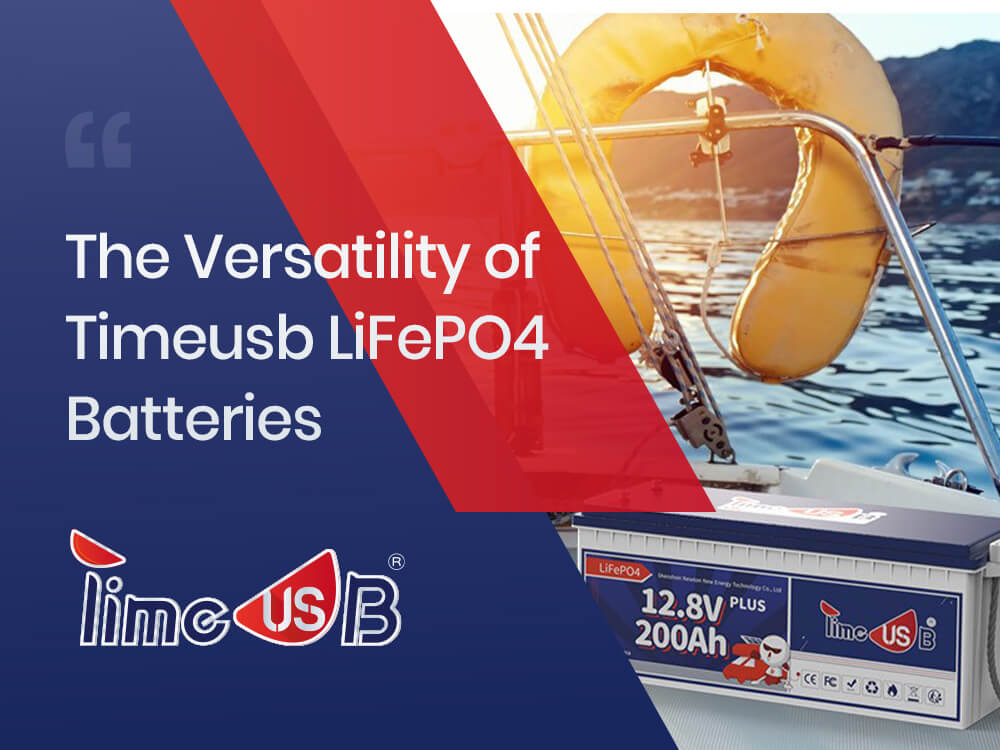
![[Full Guide] The Comprehensive Guide to LiFePO4 Battery Life](http://www.timeusbpower.com/cdn/shop/articles/The_Comprehensive_Guide_to_LiFePO4_Battery_Life_757d2749-9468-4739-ac83-0960c27749b0.jpg?v=1722918256&width=1080)
